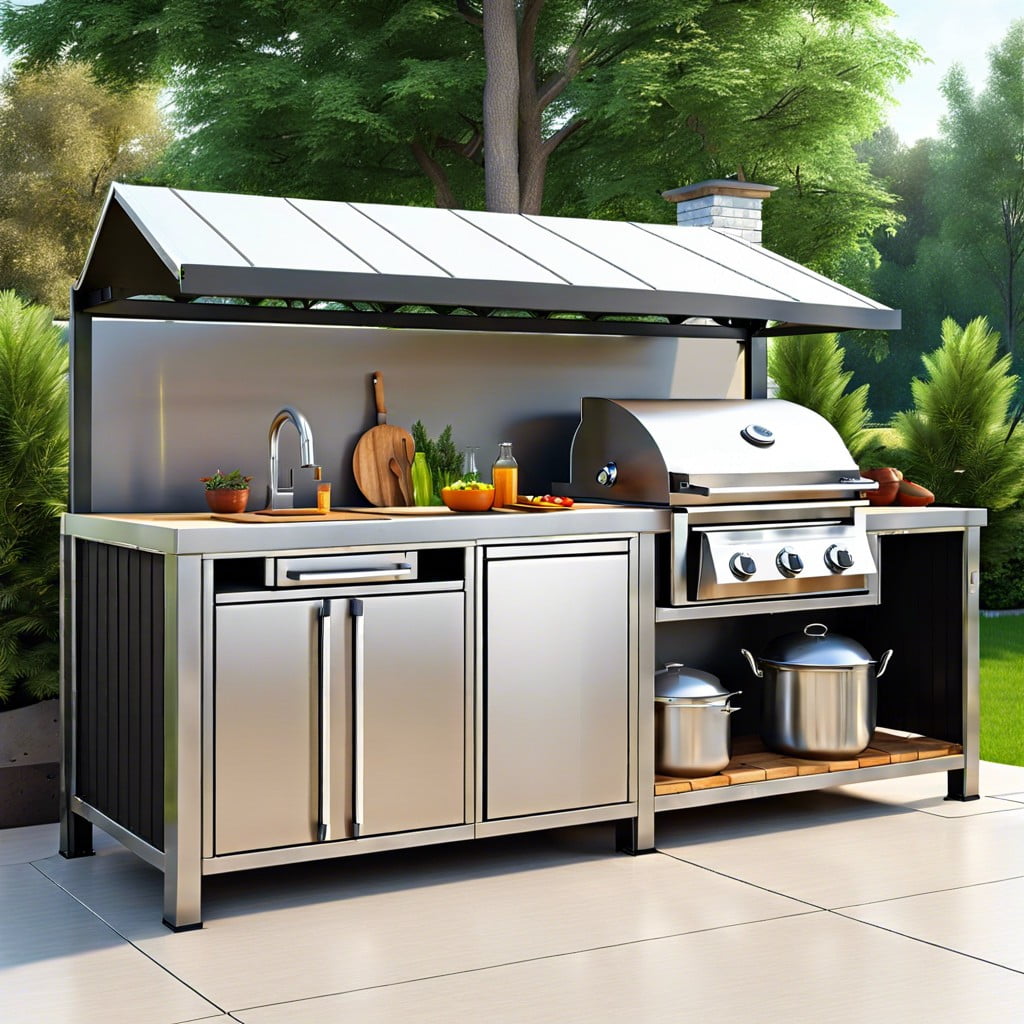This how-to guide provides step-by-step instructions on constructing a durable and stylish outdoor kitchen frame that suits your space and needs.
Key takeaways:
- Wood, cinder blocks, and steel are popular materials for outdoor kitchen framing.
- Durability, weight-bearing capacity, and resistance to the elements are important considerations.
- Efficient layout includes positioning the grill and sink, ample countertop space, and clear movement flow.
- Incorporate storage and consider bar seating or dining areas.
- Ensure safety by following building codes and proper clearance for heat sources.
Material Selection for Outdoor Kitchen Framing

When selecting materials for your outdoor kitchen frame, consider wood for its natural aesthetic and ease of customization. However, it requires regular maintenance and protection from the elements to prevent decay. In contrast, cinder blocks provide exceptional durability and require minimal upkeep but offer less flexibility in design alterations.
Steel frames, specifically stainless or galvanized steel, stand out for their superior strength and resistance to rust, making them an excellent long-term investment. Although a more costly option, steel frames support heavier countertops and appliances while withstanding harsh weather conditions.
Each material’s characteristics should align with your climate, the complexity of your outdoor kitchen design, and your maintenance willingness. Balance these factors to ensure a reliable and enduring outdoor kitchen framework.
Considerations for Wood, Cinder Blocks, and Steel Frames
When selecting materials for an outdoor kitchen frame, wood offers natural beauty and ease of manipulation. However, it requires treatment to fend off rot, pests, and weather damage. Softwoods like pine are cost-effective but less durable, while hardwoods like cedar and redwood offer greater longevity at a higher cost.
Cinder blocks provide exceptional durability and fire resistance, making them ideal for supporting heavy countertops and appliances. Their modular nature facilitates straightforward construction but often necessitates a facade or stucco finish to enhance aesthetics.
Steel frames, particularly galvanized or stainless, offer superior strength and resistance to corrosion. Their lightweight nature allows for design flexibility and the ability to withstand harsh weather conditions. They are also impervious to pests and can accommodate a sleek, modern design but typically require professional installation.
Framing Considerations
When selecting a framing material for your outdoor kitchen, durability is of the utmost importance. Frames must withstand varying weather conditions, from intense sunlight to freezing temperatures. This resilience ensures that the structure will not warp, rot, or degrade quickly over time, maintaining the integrity of your outdoor space.
Weight-bearing capacity is another critical factor. The frame must be robust enough to support heavy countertops, appliances, and any additional features such as a pizza oven or a barbecue grill. A structurally sound frame will prevent sagging and potential damage to your investment.
Moreover, when framing an outdoor kitchen, consider the resistance of the material to the elements. While treated wood can repel water and deter pests, metals like stainless steel will resist rust and corrosion. The right choice of material can vastly reduce the need for maintenance and extend the lifespan of your outdoor kitchen.
Lastly, local building codes should influence your decisions, ensuring that your outdoor kitchen framing is legally compliant and safe for use. Each decision in the framing process lays the groundwork for a functional and long-lasting outdoor entertainment area.
Durability, Weight-Bearing, and Resistance to Elements
When selecting framing materials, durability is paramount. Metals like stainless steel resist rust and corrosion, offering longevity even in harsh weather conditions. Wooden frames, while visually appealing, must be treated to withstand moisture and pests.
The weight-bearing capacity of your frame must match the weight of countertops, appliances, and guests that may lean or sit on surfaces. Structural integrity is critical for safety and ensuring that the outdoor kitchen stands the test of time.
Elemental resistance involves more than just weatherproofing against rain and snow. Consider UV radiation, which can degrade certain materials over time. Additionally, proximity to saltwater can dictate the need for higher-grade, corrosion-resistant metals.
Each material has its trade-offs between cost, maintenance, and performance in the face of these challenges. Select with foresight to minimize future repairs and replacements, ensuring your outdoor kitchen remains a focal point for gatherings for years to come.
Designing the Layout
Efficient layout is integral to the functionality of an outdoor kitchen. Begin by positioning the grill and sink, ensuring they are easily accessible and central to the design. Adjacent countertop space is important for food preparation and should be adequate to accommodate utensils and ingredients.
Factor in the flow of movement within the space. The design should allow for a clear path between the cooking area, dining spot, and indoor kitchen, if applicable. Incorporate ample storage, choosing locations that complement the chef’s workflow and keep essentials within reach, while keeping a seamless aesthetic.
Consider the inclusion of bar seating or a dining area that integrates smoothly with the kitchen layout. These areas should foster sociability without disrupting the cooking zone. Careful placement of appliances, like refrigerators and smokers, can enhance the design both functionally and visually.
Lastly, always account for safety. Ensure that heat sources have proper clearance from flammable materials and that the layout adheres to any building codes relevant to outdoor structures.
Recap




